Human Resource Management Report: Woolworths Recruitment Challenges
VerifiedAdded on 2020/03/23
|12
|2813
|44
Report
AI Summary
This report provides an executive summary and detailed analysis of the human resource management practices within Woolworths. It identifies key challenges in workforce recruitment, including labor supply and demand, organizational image, demographic issues, political-social-legal environments, unemployment rates, and the labor market. The report recommends strategies to address these challenges, such as employer branding and various types of advertising, including social media, local newspapers, company websites, and online job boards. The report also provides a comprehensive conclusion and recommendations for improving recruitment processes. The report highlights the importance of adapting to demographic changes, utilizing digital strategies, building networks, and fostering equal employment opportunities to attract and retain a skilled workforce. The report draws upon academic sources to support its findings and recommendations.
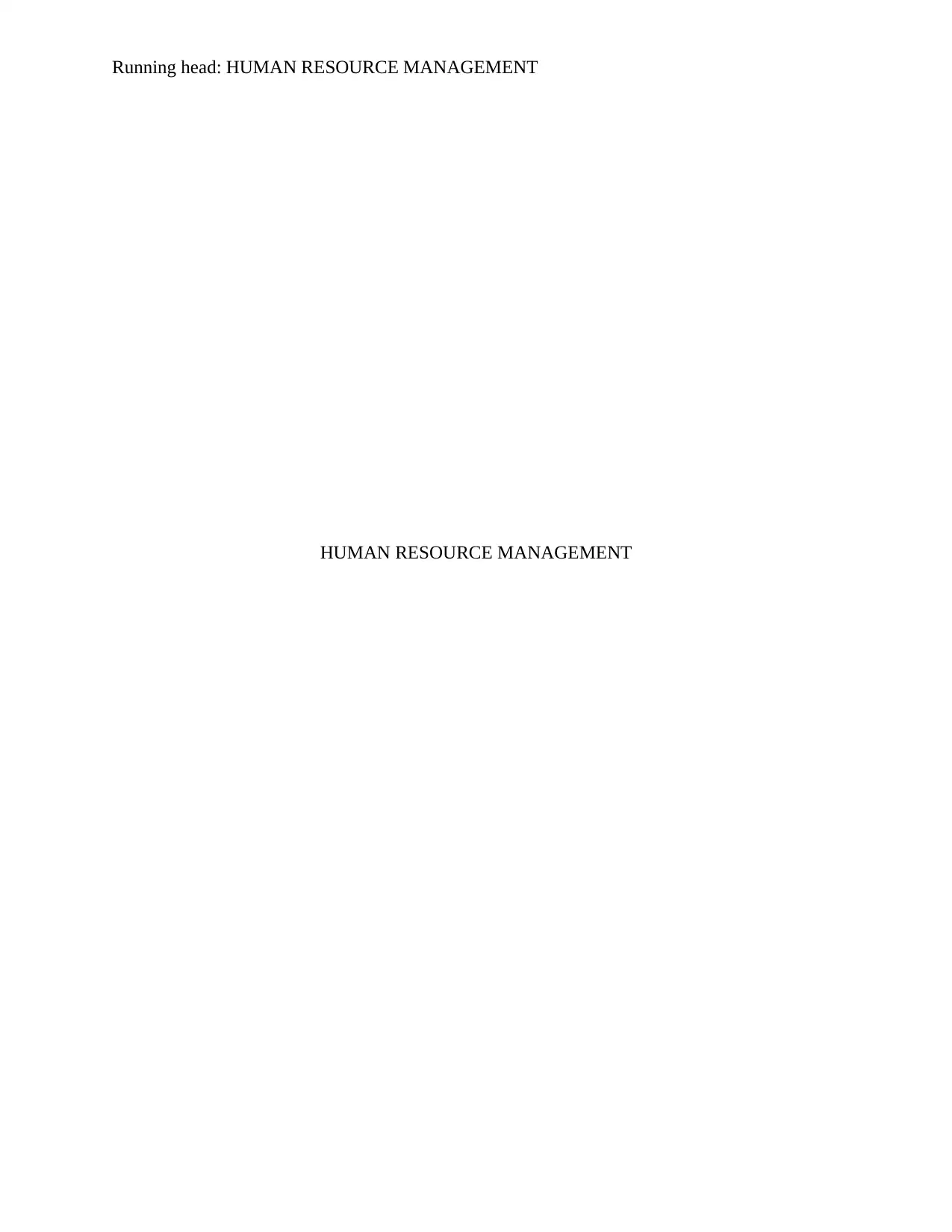
Running head: HUMAN RESOURCE MANAGEMENT
HUMAN RESOURCE MANAGEMENT
HUMAN RESOURCE MANAGEMENT
Paraphrase This Document
Need a fresh take? Get an instant paraphrase of this document with our AI Paraphraser
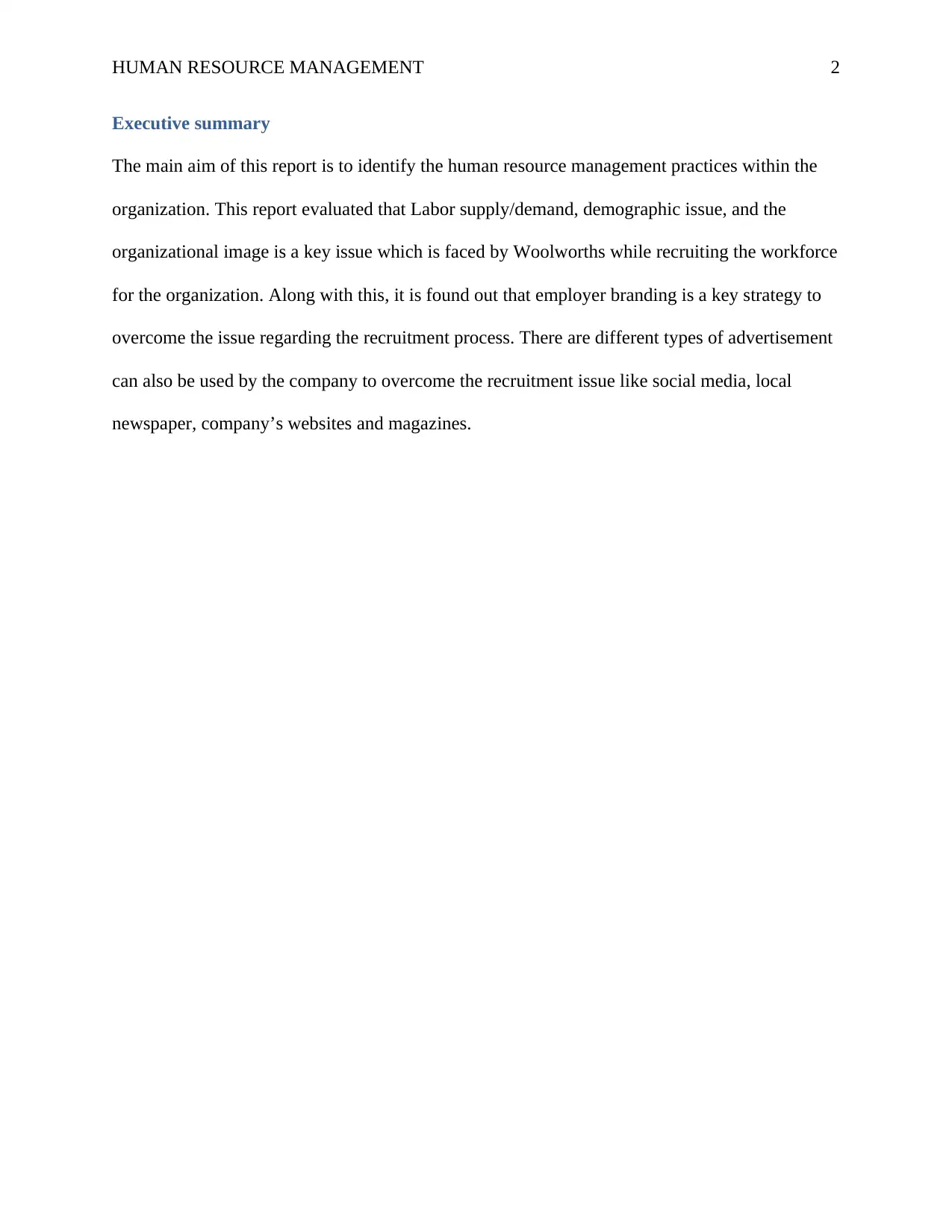
HUMAN RESOURCE MANAGEMENT 2
Executive summary
The main aim of this report is to identify the human resource management practices within the
organization. This report evaluated that Labor supply/demand, demographic issue, and the
organizational image is a key issue which is faced by Woolworths while recruiting the workforce
for the organization. Along with this, it is found out that employer branding is a key strategy to
overcome the issue regarding the recruitment process. There are different types of advertisement
can also be used by the company to overcome the recruitment issue like social media, local
newspaper, company’s websites and magazines.
Executive summary
The main aim of this report is to identify the human resource management practices within the
organization. This report evaluated that Labor supply/demand, demographic issue, and the
organizational image is a key issue which is faced by Woolworths while recruiting the workforce
for the organization. Along with this, it is found out that employer branding is a key strategy to
overcome the issue regarding the recruitment process. There are different types of advertisement
can also be used by the company to overcome the recruitment issue like social media, local
newspaper, company’s websites and magazines.
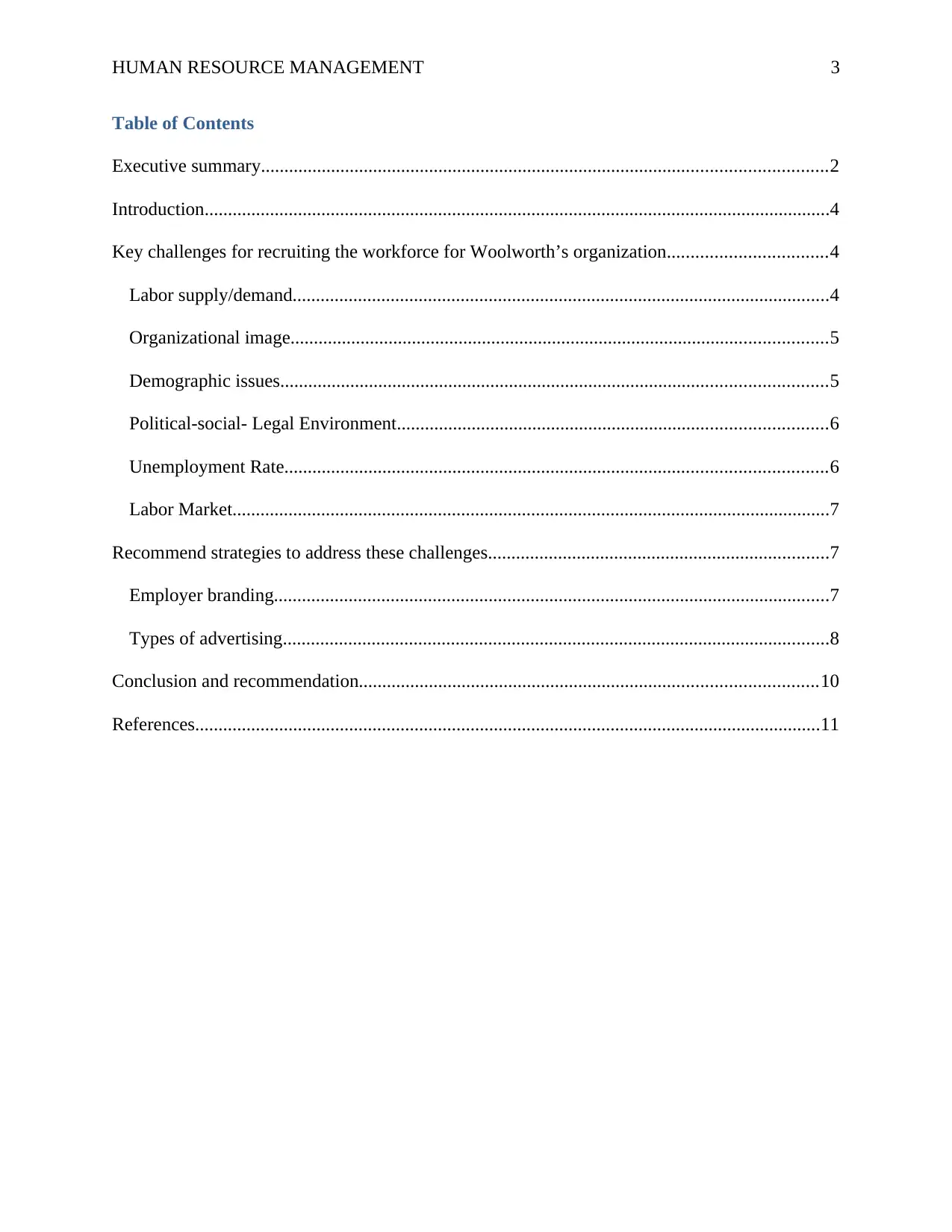
HUMAN RESOURCE MANAGEMENT 3
Table of Contents
Executive summary.........................................................................................................................2
Introduction......................................................................................................................................4
Key challenges for recruiting the workforce for Woolworth’s organization..................................4
Labor supply/demand...................................................................................................................4
Organizational image...................................................................................................................5
Demographic issues.....................................................................................................................5
Political-social- Legal Environment............................................................................................6
Unemployment Rate....................................................................................................................6
Labor Market................................................................................................................................7
Recommend strategies to address these challenges.........................................................................7
Employer branding.......................................................................................................................7
Types of advertising.....................................................................................................................8
Conclusion and recommendation..................................................................................................10
References......................................................................................................................................11
Table of Contents
Executive summary.........................................................................................................................2
Introduction......................................................................................................................................4
Key challenges for recruiting the workforce for Woolworth’s organization..................................4
Labor supply/demand...................................................................................................................4
Organizational image...................................................................................................................5
Demographic issues.....................................................................................................................5
Political-social- Legal Environment............................................................................................6
Unemployment Rate....................................................................................................................6
Labor Market................................................................................................................................7
Recommend strategies to address these challenges.........................................................................7
Employer branding.......................................................................................................................7
Types of advertising.....................................................................................................................8
Conclusion and recommendation..................................................................................................10
References......................................................................................................................................11
⊘ This is a preview!⊘
Do you want full access?
Subscribe today to unlock all pages.

Trusted by 1+ million students worldwide

HUMAN RESOURCE MANAGEMENT 4
Introduction
In the current business scenario, recruitment is the key challenging factor that is faced by
companies in the Australia. Further, supervisors, managers, and human resources managers
within an organization always look towards resolving the challenges of recruitment of their
workforces. In Addition, high vacancy rate, turnover, and poor staff training are expensive for
the organization, as well as this condition may generate detrimental outcome within the
organization. Therefore, it is essential for organization to assess and execute the effective
strategies to overcome these workforce recruitment challenges (Lai, et. al., 2016). This report
presents the certain challenges for recruiting the workforce within Woolworth’s organization. It
also recommends different strategies to address these challenges.
Key challenges for recruiting the workforce for Woolworth’s organization
Labor supply/demand
Labor supply and demand is the key issue for recruiting the workforce within Woolworths,
Australia. The availability of labor in both outside and inside the corporation is an essential
factor in the recruitment procedure. It is analyzed that Woolworths has a demand for more
qualified person but there is an inadequate supply in the market with respect to a qualified
workforce. Therefore, the company has to depend on the internal resources by facilitating them
development initiatives and special training (Curtis, and Reid, 2013).
Moreover, supply and demand of specific skills are required by Woolworths in the labor market.
In the Australian labor market, demand for skills is high relative to the supply as extraordinary
recruiting efforts may be required. For example, the demand for financial analyst and marketing
manager is likely to be higher as compared to their supply. Along with this, supply and demand
Introduction
In the current business scenario, recruitment is the key challenging factor that is faced by
companies in the Australia. Further, supervisors, managers, and human resources managers
within an organization always look towards resolving the challenges of recruitment of their
workforces. In Addition, high vacancy rate, turnover, and poor staff training are expensive for
the organization, as well as this condition may generate detrimental outcome within the
organization. Therefore, it is essential for organization to assess and execute the effective
strategies to overcome these workforce recruitment challenges (Lai, et. al., 2016). This report
presents the certain challenges for recruiting the workforce within Woolworth’s organization. It
also recommends different strategies to address these challenges.
Key challenges for recruiting the workforce for Woolworth’s organization
Labor supply/demand
Labor supply and demand is the key issue for recruiting the workforce within Woolworths,
Australia. The availability of labor in both outside and inside the corporation is an essential
factor in the recruitment procedure. It is analyzed that Woolworths has a demand for more
qualified person but there is an inadequate supply in the market with respect to a qualified
workforce. Therefore, the company has to depend on the internal resources by facilitating them
development initiatives and special training (Curtis, and Reid, 2013).
Moreover, supply and demand of specific skills are required by Woolworths in the labor market.
In the Australian labor market, demand for skills is high relative to the supply as extraordinary
recruiting efforts may be required. For example, the demand for financial analyst and marketing
manager is likely to be higher as compared to their supply. Along with this, supply and demand
Paraphrase This Document
Need a fresh take? Get an instant paraphrase of this document with our AI Paraphraser

HUMAN RESOURCE MANAGEMENT 5
relationships for non-technical employees are opposite to technical employees in Australia
(Mabaya, et. al., 2016).
Organizational image
Image of the organization can act as prospect constraint for recruitment. It is analyzed that
Woolworths has positive image and goodwill as an employer hence it could be easier for this
firm to attract and retain their workforce as compared to an organization with a negative image.
Image of a company relies on its performance in the retail industry. For instance, products are
highly purchased by people when supermarkets were coming up in the Australia (Holbeche,
2015).
Demographic issues
Demographic change is the key challenge for the organization in recruiting the workforce. It can
be evaluated that Woolworths faced demographic issue for recruiting the employees hence it
needs to adapt the effective recruitment practices for responding towards increasing diversity
within the labor markets. Diversity can change the pool of expected workforces and the
requirement of workforces. Together with, it influences the extensive business objectives such as
provisions related to service. Furthermore, the continual modification in the demographic profile
and extensive population indicates that organizations need to build strategies that will attain the
requirements and wishes of the Australian people (Hairon, and Tan, 2017).
There is certain demographic and social alteration is outlined below:
Ageing population
• Force regarding welfare and health facilities
• Voluntary compassionate act by the people
• Favorable aging and ongoing withdrawal
relationships for non-technical employees are opposite to technical employees in Australia
(Mabaya, et. al., 2016).
Organizational image
Image of the organization can act as prospect constraint for recruitment. It is analyzed that
Woolworths has positive image and goodwill as an employer hence it could be easier for this
firm to attract and retain their workforce as compared to an organization with a negative image.
Image of a company relies on its performance in the retail industry. For instance, products are
highly purchased by people when supermarkets were coming up in the Australia (Holbeche,
2015).
Demographic issues
Demographic change is the key challenge for the organization in recruiting the workforce. It can
be evaluated that Woolworths faced demographic issue for recruiting the employees hence it
needs to adapt the effective recruitment practices for responding towards increasing diversity
within the labor markets. Diversity can change the pool of expected workforces and the
requirement of workforces. Together with, it influences the extensive business objectives such as
provisions related to service. Furthermore, the continual modification in the demographic profile
and extensive population indicates that organizations need to build strategies that will attain the
requirements and wishes of the Australian people (Hairon, and Tan, 2017).
There is certain demographic and social alteration is outlined below:
Ageing population
• Force regarding welfare and health facilities
• Voluntary compassionate act by the people
• Favorable aging and ongoing withdrawal
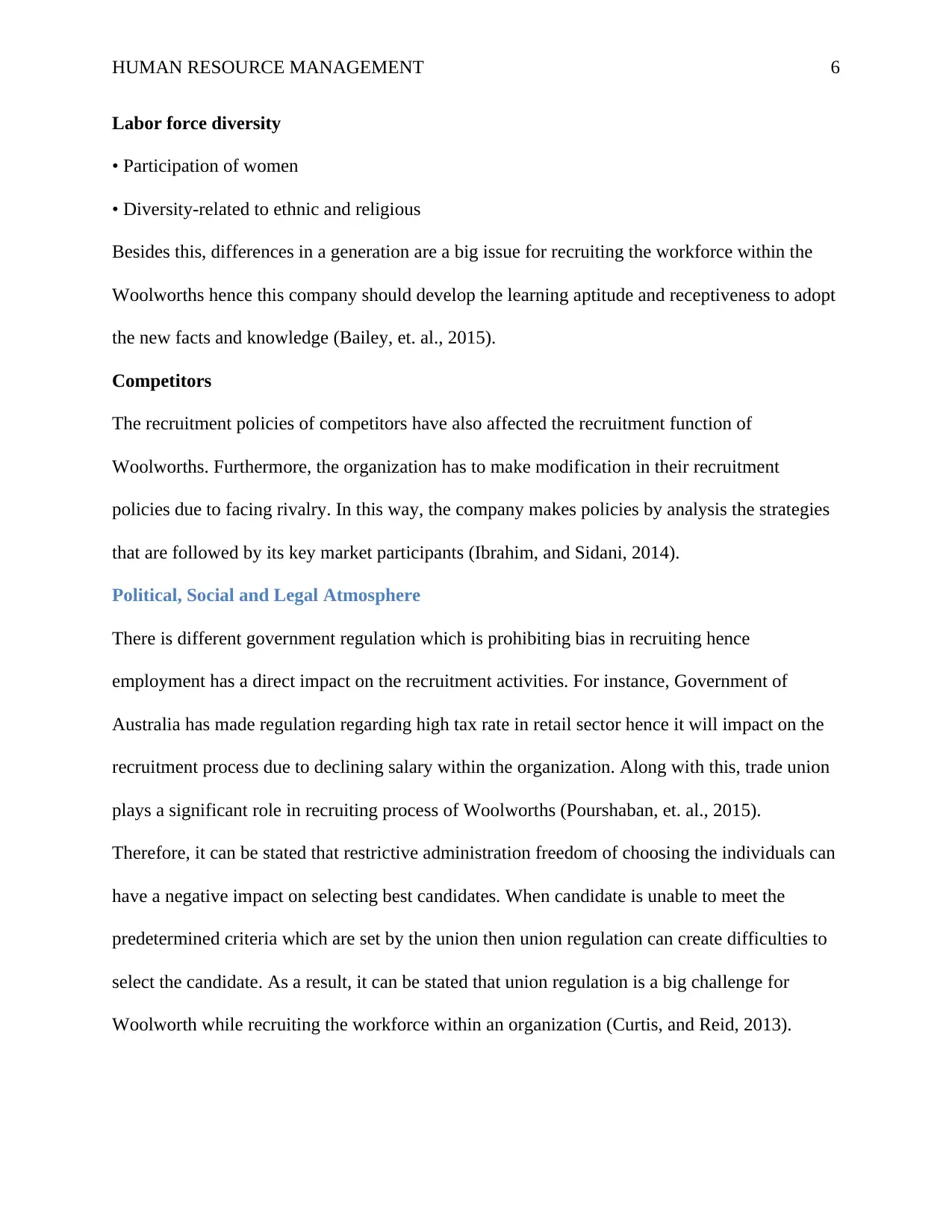
HUMAN RESOURCE MANAGEMENT 6
Labor force diversity
• Participation of women
• Diversity-related to ethnic and religious
Besides this, differences in a generation are a big issue for recruiting the workforce within the
Woolworths hence this company should develop the learning aptitude and receptiveness to adopt
the new facts and knowledge (Bailey, et. al., 2015).
Competitors
The recruitment policies of competitors have also affected the recruitment function of
Woolworths. Furthermore, the organization has to make modification in their recruitment
policies due to facing rivalry. In this way, the company makes policies by analysis the strategies
that are followed by its key market participants (Ibrahim, and Sidani, 2014).
Political, Social and Legal Atmosphere
There is different government regulation which is prohibiting bias in recruiting hence
employment has a direct impact on the recruitment activities. For instance, Government of
Australia has made regulation regarding high tax rate in retail sector hence it will impact on the
recruitment process due to declining salary within the organization. Along with this, trade union
plays a significant role in recruiting process of Woolworths (Pourshaban, et. al., 2015).
Therefore, it can be stated that restrictive administration freedom of choosing the individuals can
have a negative impact on selecting best candidates. When candidate is unable to meet the
predetermined criteria which are set by the union then union regulation can create difficulties to
select the candidate. As a result, it can be stated that union regulation is a big challenge for
Woolworth while recruiting the workforce within an organization (Curtis, and Reid, 2013).
Labor force diversity
• Participation of women
• Diversity-related to ethnic and religious
Besides this, differences in a generation are a big issue for recruiting the workforce within the
Woolworths hence this company should develop the learning aptitude and receptiveness to adopt
the new facts and knowledge (Bailey, et. al., 2015).
Competitors
The recruitment policies of competitors have also affected the recruitment function of
Woolworths. Furthermore, the organization has to make modification in their recruitment
policies due to facing rivalry. In this way, the company makes policies by analysis the strategies
that are followed by its key market participants (Ibrahim, and Sidani, 2014).
Political, Social and Legal Atmosphere
There is different government regulation which is prohibiting bias in recruiting hence
employment has a direct impact on the recruitment activities. For instance, Government of
Australia has made regulation regarding high tax rate in retail sector hence it will impact on the
recruitment process due to declining salary within the organization. Along with this, trade union
plays a significant role in recruiting process of Woolworths (Pourshaban, et. al., 2015).
Therefore, it can be stated that restrictive administration freedom of choosing the individuals can
have a negative impact on selecting best candidates. When candidate is unable to meet the
predetermined criteria which are set by the union then union regulation can create difficulties to
select the candidate. As a result, it can be stated that union regulation is a big challenge for
Woolworth while recruiting the workforce within an organization (Curtis, and Reid, 2013).
⊘ This is a preview!⊘
Do you want full access?
Subscribe today to unlock all pages.

Trusted by 1+ million students worldwide
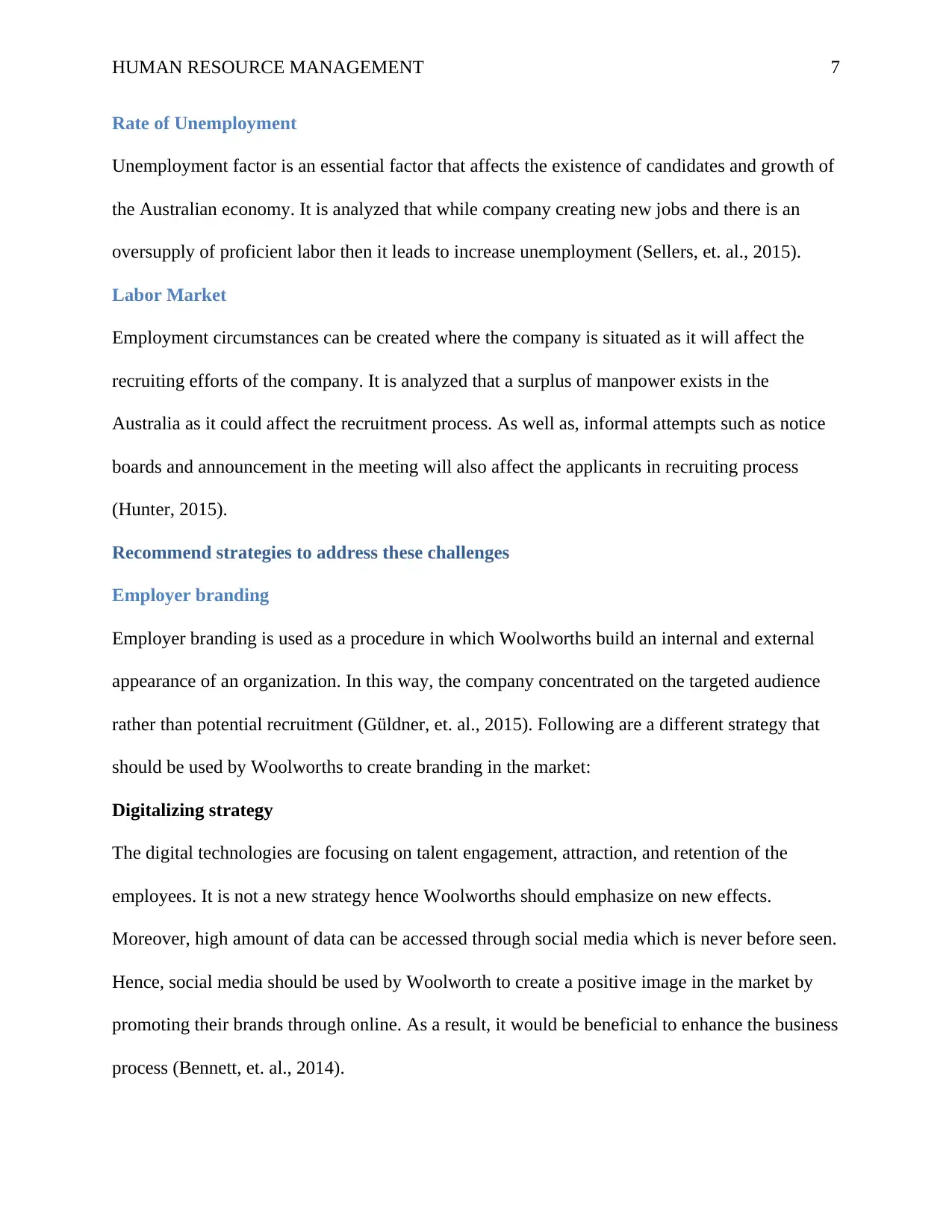
HUMAN RESOURCE MANAGEMENT 7
Rate of Unemployment
Unemployment factor is an essential factor that affects the existence of candidates and growth of
the Australian economy. It is analyzed that while company creating new jobs and there is an
oversupply of proficient labor then it leads to increase unemployment (Sellers, et. al., 2015).
Labor Market
Employment circumstances can be created where the company is situated as it will affect the
recruiting efforts of the company. It is analyzed that a surplus of manpower exists in the
Australia as it could affect the recruitment process. As well as, informal attempts such as notice
boards and announcement in the meeting will also affect the applicants in recruiting process
(Hunter, 2015).
Recommend strategies to address these challenges
Employer branding
Employer branding is used as a procedure in which Woolworths build an internal and external
appearance of an organization. In this way, the company concentrated on the targeted audience
rather than potential recruitment (Güldner, et. al., 2015). Following are a different strategy that
should be used by Woolworths to create branding in the market:
Digitalizing strategy
The digital technologies are focusing on talent engagement, attraction, and retention of the
employees. It is not a new strategy hence Woolworths should emphasize on new effects.
Moreover, high amount of data can be accessed through social media which is never before seen.
Hence, social media should be used by Woolworth to create a positive image in the market by
promoting their brands through online. As a result, it would be beneficial to enhance the business
process (Bennett, et. al., 2014).
Rate of Unemployment
Unemployment factor is an essential factor that affects the existence of candidates and growth of
the Australian economy. It is analyzed that while company creating new jobs and there is an
oversupply of proficient labor then it leads to increase unemployment (Sellers, et. al., 2015).
Labor Market
Employment circumstances can be created where the company is situated as it will affect the
recruiting efforts of the company. It is analyzed that a surplus of manpower exists in the
Australia as it could affect the recruitment process. As well as, informal attempts such as notice
boards and announcement in the meeting will also affect the applicants in recruiting process
(Hunter, 2015).
Recommend strategies to address these challenges
Employer branding
Employer branding is used as a procedure in which Woolworths build an internal and external
appearance of an organization. In this way, the company concentrated on the targeted audience
rather than potential recruitment (Güldner, et. al., 2015). Following are a different strategy that
should be used by Woolworths to create branding in the market:
Digitalizing strategy
The digital technologies are focusing on talent engagement, attraction, and retention of the
employees. It is not a new strategy hence Woolworths should emphasize on new effects.
Moreover, high amount of data can be accessed through social media which is never before seen.
Hence, social media should be used by Woolworth to create a positive image in the market by
promoting their brands through online. As a result, it would be beneficial to enhance the business
process (Bennett, et. al., 2014).
Paraphrase This Document
Need a fresh take? Get an instant paraphrase of this document with our AI Paraphraser

HUMAN RESOURCE MANAGEMENT 8
Creating network
The key to improving the branding in the market is to constantly organically produce the
network. The company should also make strategies to reach the global level network as it would
be diverse enough to make sure that company is connecting with people who have a range of
skills and diverse backgrounds (Curtis, and Reid, 2013).
Increase lifelong learning and experience
Woolworths should create self-learning by taking feedback from employees and train them on
how to deliver the information to customers. There is a number of open sources and free
company websites available for people with internet connection as they can share their
experience regarding job (Pourshaban, et. al., 2015).
CSR engagement
CSR can be an effective strategy to build employer branding of Woolworths as it affects how
people observe a brand positioning in the market as compared to key market participants.
Effective flow of communication
The company should use a certain tool like Woolworths should use customer service to aid the
communication flow outside and inside of an organization. These techniques can provide support
to Woolworths to become smarter for all sizes work and become more responsive and make
rapid innovation in the retail industry (Bennett, et. al., 2014).
Equal Employment opportunity
It is analyzed that when people connect with any company then they can be either too excited or
nervous. Hence, Woolworths should provide the equal opportunity to their employees and should
deal with them as an experience people (Güldner, et. al., 2015).
Creating network
The key to improving the branding in the market is to constantly organically produce the
network. The company should also make strategies to reach the global level network as it would
be diverse enough to make sure that company is connecting with people who have a range of
skills and diverse backgrounds (Curtis, and Reid, 2013).
Increase lifelong learning and experience
Woolworths should create self-learning by taking feedback from employees and train them on
how to deliver the information to customers. There is a number of open sources and free
company websites available for people with internet connection as they can share their
experience regarding job (Pourshaban, et. al., 2015).
CSR engagement
CSR can be an effective strategy to build employer branding of Woolworths as it affects how
people observe a brand positioning in the market as compared to key market participants.
Effective flow of communication
The company should use a certain tool like Woolworths should use customer service to aid the
communication flow outside and inside of an organization. These techniques can provide support
to Woolworths to become smarter for all sizes work and become more responsive and make
rapid innovation in the retail industry (Bennett, et. al., 2014).
Equal Employment opportunity
It is analyzed that when people connect with any company then they can be either too excited or
nervous. Hence, Woolworths should provide the equal opportunity to their employees and should
deal with them as an experience people (Güldner, et. al., 2015).

HUMAN RESOURCE MANAGEMENT 9
Types of advertising
Woolworths should also use different kinds of advertising to recruit the workforce within the
organization. It is discussed as below:
Local Newspaper
The local paper has a classified part in which local job-seeker look to search their next career
step. It can be an effective medium to match the requirement of people with the company’s’
requirement. It can be more beneficial to recruit the local candidates as they have more idea
about local language and culture. The main disadvantage of using advertisement in a newspaper
is that it takes lots of space to fit the description of the job and also it could be more expensive
(Pourshaban, et. al., 2015).
Online Job Board
There are certain online job boards in the Australia such as Career One, MyCareer and SEEK
which enable the company to recruit best candidates. However, there are certain retail industry-
specific boards which can help the company to target the right candidates. The company should
use the internet to find for retail industry-specific jobs as it would be beneficial to obtain the idea
about selecting candidates. However, it can be more time-consuming (Hunter, 2015).
Company Website and Newsletter
The company should also use its websites to advertise the job. This can be beneficial for that
individual who looks at the Woolworth’s website and understands the retail industry. As a result,
it could be a good source of recruiting candidates. It can also provide the good opportunity for
the internal candidates to apply in case external candidates are unaware regarding the vacancy
(Sellers, et. al., 2015).
Social Media
Types of advertising
Woolworths should also use different kinds of advertising to recruit the workforce within the
organization. It is discussed as below:
Local Newspaper
The local paper has a classified part in which local job-seeker look to search their next career
step. It can be an effective medium to match the requirement of people with the company’s’
requirement. It can be more beneficial to recruit the local candidates as they have more idea
about local language and culture. The main disadvantage of using advertisement in a newspaper
is that it takes lots of space to fit the description of the job and also it could be more expensive
(Pourshaban, et. al., 2015).
Online Job Board
There are certain online job boards in the Australia such as Career One, MyCareer and SEEK
which enable the company to recruit best candidates. However, there are certain retail industry-
specific boards which can help the company to target the right candidates. The company should
use the internet to find for retail industry-specific jobs as it would be beneficial to obtain the idea
about selecting candidates. However, it can be more time-consuming (Hunter, 2015).
Company Website and Newsletter
The company should also use its websites to advertise the job. This can be beneficial for that
individual who looks at the Woolworth’s website and understands the retail industry. As a result,
it could be a good source of recruiting candidates. It can also provide the good opportunity for
the internal candidates to apply in case external candidates are unaware regarding the vacancy
(Sellers, et. al., 2015).
Social Media
⊘ This is a preview!⊘
Do you want full access?
Subscribe today to unlock all pages.

Trusted by 1+ million students worldwide

HUMAN RESOURCE MANAGEMENT 10
Social media is another type of advertisement tool which is used to recruit the potential
applicants. For example, Woolworths can use the facebook page, and twitter feed to post the
advertisement and link related to recruitment. It can also encourage the followers to share the
post with their network. Along with this, professional network like LinkedIn can be used by
Woolworths to create the awareness about the vacancy and can also lead their colleagues and
workforce to share the advertisement with their networks (Güldner, et. al., 2015).
It can be stated that if the company will use recruitment agency then they will support the
organization to write an advertisement and also appeal to select the right candidates. However,
online advertising is generally takes high fees because they use their proficiency to screen the
resumes and choose relevant applicants to move the company to approve the next phase of the
recruitment process (Curtis, and Reid, 2013).
Conclusion and recommendation
From the above interpretation, it can be concluded that there are different challenges faced by
Woolworths at the time of recruiting the workforces within the organization. These challenges
are labor supply and demand, organizational image, demographic issues, labor market,
competitors and Political, Social and Legal Environment. It can be summarized that there are
different strategy is used to overcome the recruitment process issues like employer branding and
different type of advertisement strategy. From the above findings, it can be recommended that
company can use different sourcing techniques to reach the appropriate applicants. In this way, it
can use job sites, company’s websites, referrals, alumni association, social media, job fairs and
different channels to find applicants (Güldner, et. al., 2015). Along with this, Woolworths should
keep the record of the candidates rather than focusing on which method was used.
Social media is another type of advertisement tool which is used to recruit the potential
applicants. For example, Woolworths can use the facebook page, and twitter feed to post the
advertisement and link related to recruitment. It can also encourage the followers to share the
post with their network. Along with this, professional network like LinkedIn can be used by
Woolworths to create the awareness about the vacancy and can also lead their colleagues and
workforce to share the advertisement with their networks (Güldner, et. al., 2015).
It can be stated that if the company will use recruitment agency then they will support the
organization to write an advertisement and also appeal to select the right candidates. However,
online advertising is generally takes high fees because they use their proficiency to screen the
resumes and choose relevant applicants to move the company to approve the next phase of the
recruitment process (Curtis, and Reid, 2013).
Conclusion and recommendation
From the above interpretation, it can be concluded that there are different challenges faced by
Woolworths at the time of recruiting the workforces within the organization. These challenges
are labor supply and demand, organizational image, demographic issues, labor market,
competitors and Political, Social and Legal Environment. It can be summarized that there are
different strategy is used to overcome the recruitment process issues like employer branding and
different type of advertisement strategy. From the above findings, it can be recommended that
company can use different sourcing techniques to reach the appropriate applicants. In this way, it
can use job sites, company’s websites, referrals, alumni association, social media, job fairs and
different channels to find applicants (Güldner, et. al., 2015). Along with this, Woolworths should
keep the record of the candidates rather than focusing on which method was used.
Paraphrase This Document
Need a fresh take? Get an instant paraphrase of this document with our AI Paraphraser
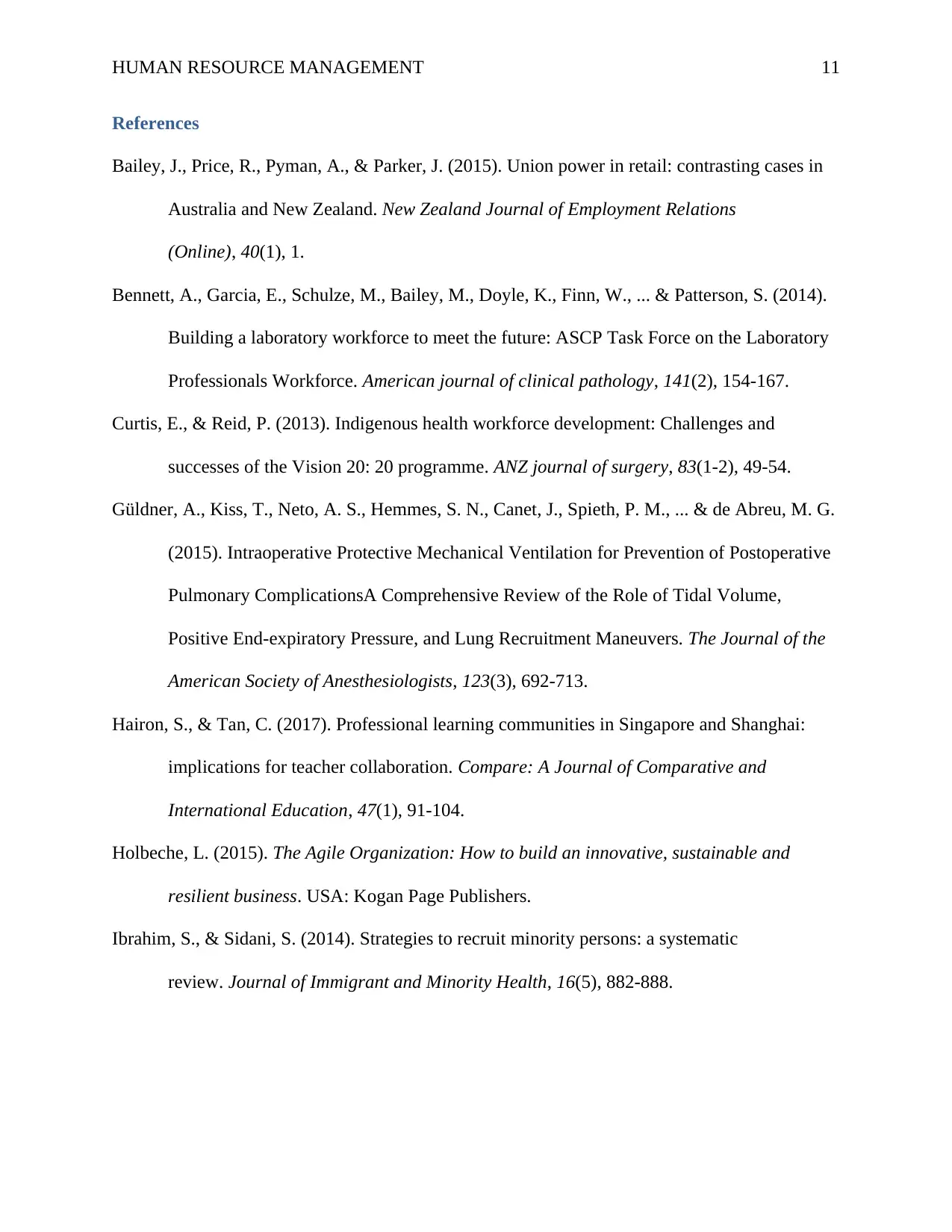
HUMAN RESOURCE MANAGEMENT 11
References
Bailey, J., Price, R., Pyman, A., & Parker, J. (2015). Union power in retail: contrasting cases in
Australia and New Zealand. New Zealand Journal of Employment Relations
(Online), 40(1), 1.
Bennett, A., Garcia, E., Schulze, M., Bailey, M., Doyle, K., Finn, W., ... & Patterson, S. (2014).
Building a laboratory workforce to meet the future: ASCP Task Force on the Laboratory
Professionals Workforce. American journal of clinical pathology, 141(2), 154-167.
Curtis, E., & Reid, P. (2013). Indigenous health workforce development: Challenges and
successes of the Vision 20: 20 programme. ANZ journal of surgery, 83(1-2), 49-54.
Güldner, A., Kiss, T., Neto, A. S., Hemmes, S. N., Canet, J., Spieth, P. M., ... & de Abreu, M. G.
(2015). Intraoperative Protective Mechanical Ventilation for Prevention of Postoperative
Pulmonary ComplicationsA Comprehensive Review of the Role of Tidal Volume,
Positive End-expiratory Pressure, and Lung Recruitment Maneuvers. The Journal of the
American Society of Anesthesiologists, 123(3), 692-713.
Hairon, S., & Tan, C. (2017). Professional learning communities in Singapore and Shanghai:
implications for teacher collaboration. Compare: A Journal of Comparative and
International Education, 47(1), 91-104.
Holbeche, L. (2015). The Agile Organization: How to build an innovative, sustainable and
resilient business. USA: Kogan Page Publishers.
Ibrahim, S., & Sidani, S. (2014). Strategies to recruit minority persons: a systematic
review. Journal of Immigrant and Minority Health, 16(5), 882-888.
References
Bailey, J., Price, R., Pyman, A., & Parker, J. (2015). Union power in retail: contrasting cases in
Australia and New Zealand. New Zealand Journal of Employment Relations
(Online), 40(1), 1.
Bennett, A., Garcia, E., Schulze, M., Bailey, M., Doyle, K., Finn, W., ... & Patterson, S. (2014).
Building a laboratory workforce to meet the future: ASCP Task Force on the Laboratory
Professionals Workforce. American journal of clinical pathology, 141(2), 154-167.
Curtis, E., & Reid, P. (2013). Indigenous health workforce development: Challenges and
successes of the Vision 20: 20 programme. ANZ journal of surgery, 83(1-2), 49-54.
Güldner, A., Kiss, T., Neto, A. S., Hemmes, S. N., Canet, J., Spieth, P. M., ... & de Abreu, M. G.
(2015). Intraoperative Protective Mechanical Ventilation for Prevention of Postoperative
Pulmonary ComplicationsA Comprehensive Review of the Role of Tidal Volume,
Positive End-expiratory Pressure, and Lung Recruitment Maneuvers. The Journal of the
American Society of Anesthesiologists, 123(3), 692-713.
Hairon, S., & Tan, C. (2017). Professional learning communities in Singapore and Shanghai:
implications for teacher collaboration. Compare: A Journal of Comparative and
International Education, 47(1), 91-104.
Holbeche, L. (2015). The Agile Organization: How to build an innovative, sustainable and
resilient business. USA: Kogan Page Publishers.
Ibrahim, S., & Sidani, S. (2014). Strategies to recruit minority persons: a systematic
review. Journal of Immigrant and Minority Health, 16(5), 882-888.
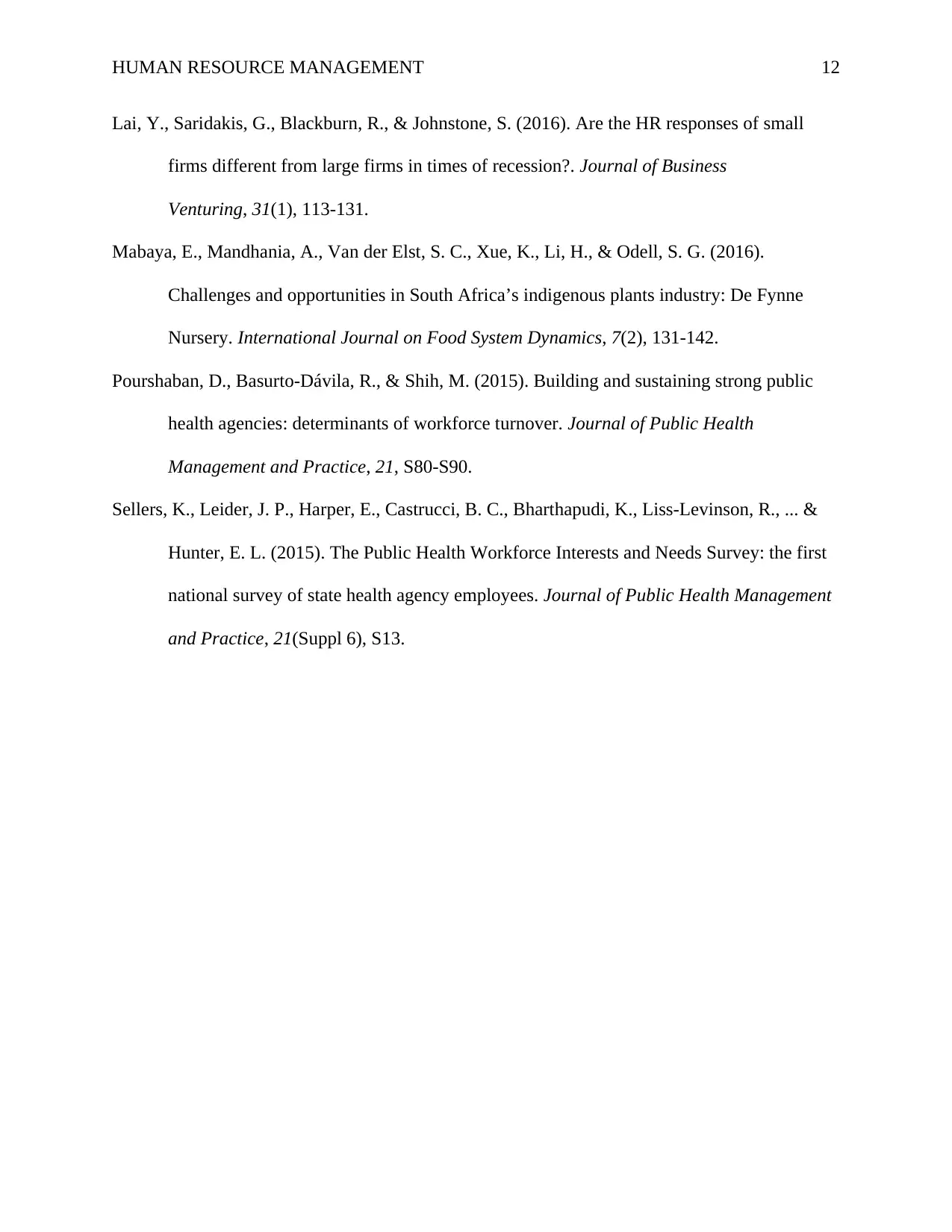
HUMAN RESOURCE MANAGEMENT 12
Lai, Y., Saridakis, G., Blackburn, R., & Johnstone, S. (2016). Are the HR responses of small
firms different from large firms in times of recession?. Journal of Business
Venturing, 31(1), 113-131.
Mabaya, E., Mandhania, A., Van der Elst, S. C., Xue, K., Li, H., & Odell, S. G. (2016).
Challenges and opportunities in South Africa’s indigenous plants industry: De Fynne
Nursery. International Journal on Food System Dynamics, 7(2), 131-142.
Pourshaban, D., Basurto-Dávila, R., & Shih, M. (2015). Building and sustaining strong public
health agencies: determinants of workforce turnover. Journal of Public Health
Management and Practice, 21, S80-S90.
Sellers, K., Leider, J. P., Harper, E., Castrucci, B. C., Bharthapudi, K., Liss-Levinson, R., ... &
Hunter, E. L. (2015). The Public Health Workforce Interests and Needs Survey: the first
national survey of state health agency employees. Journal of Public Health Management
and Practice, 21(Suppl 6), S13.
Lai, Y., Saridakis, G., Blackburn, R., & Johnstone, S. (2016). Are the HR responses of small
firms different from large firms in times of recession?. Journal of Business
Venturing, 31(1), 113-131.
Mabaya, E., Mandhania, A., Van der Elst, S. C., Xue, K., Li, H., & Odell, S. G. (2016).
Challenges and opportunities in South Africa’s indigenous plants industry: De Fynne
Nursery. International Journal on Food System Dynamics, 7(2), 131-142.
Pourshaban, D., Basurto-Dávila, R., & Shih, M. (2015). Building and sustaining strong public
health agencies: determinants of workforce turnover. Journal of Public Health
Management and Practice, 21, S80-S90.
Sellers, K., Leider, J. P., Harper, E., Castrucci, B. C., Bharthapudi, K., Liss-Levinson, R., ... &
Hunter, E. L. (2015). The Public Health Workforce Interests and Needs Survey: the first
national survey of state health agency employees. Journal of Public Health Management
and Practice, 21(Suppl 6), S13.
⊘ This is a preview!⊘
Do you want full access?
Subscribe today to unlock all pages.

Trusted by 1+ million students worldwide
1 out of 12
Related Documents
Your All-in-One AI-Powered Toolkit for Academic Success.
+13062052269
info@desklib.com
Available 24*7 on WhatsApp / Email
![[object Object]](/_next/static/media/star-bottom.7253800d.svg)
Unlock your academic potential
Copyright © 2020–2025 A2Z Services. All Rights Reserved. Developed and managed by ZUCOL.





